Well Drillers Face Down River for Decommissioning Job
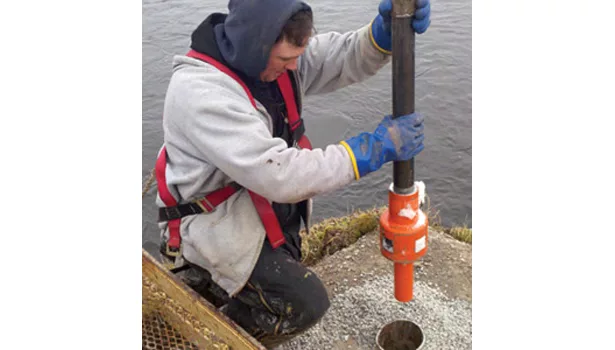
A picture from a few months before the decommissioning job shows the well rising from the Madison River. Source: Scott Blossom
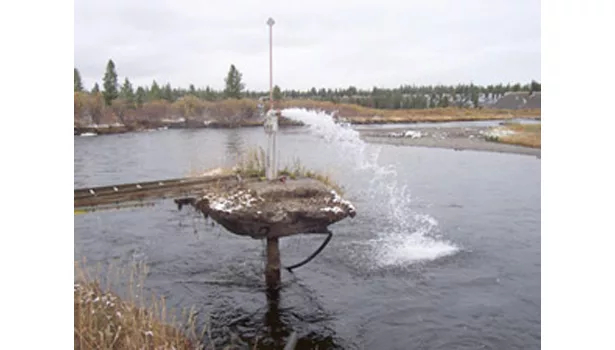
Drillers decomission a well in Montana. The state wanted the flow of this 100-gpm well plugged. Source: Dave Potts photos
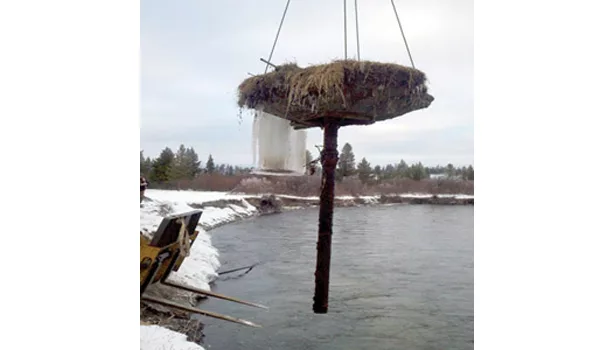
A crane lifts the cut casing from the Madison River. Source: Dave Potts
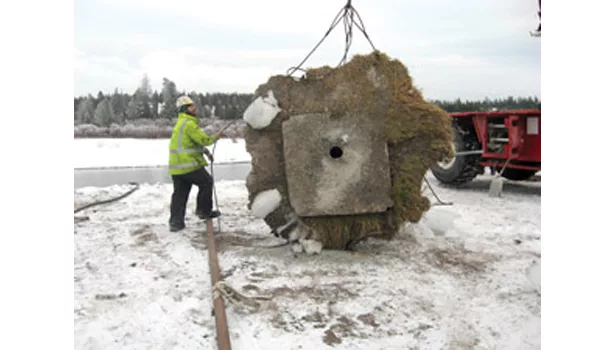
A workman unhooks the top casing of the well from the lift after it was pulled from the river. Source: Dave Potts
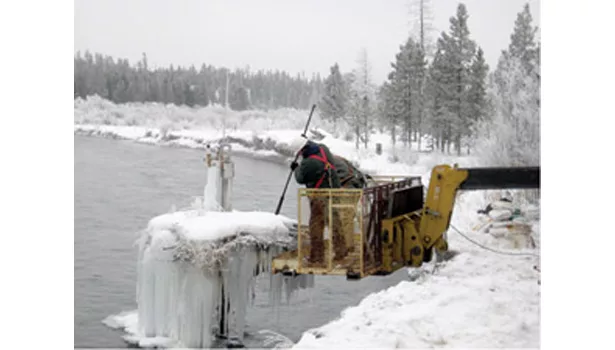
A workman with Potts Drilling of Bozeman, Mont., prepares to run a Rampp casing cutter. The state required the casing be cut four feet below the river bed.
Editor’s note: Steve Kaser wrote about a remote, summer 2011 drilling job for April’s National Driller. This story describes a challenging Montana well decommissioning job from winter 2011.
In summer 2011, I had been involved in the drilling of a water well at a remote, fly-in-only hunting lodge in northeast Oregon and subsequently put together an article on the project for the various state association bulletins. (That article was republished in National Driller in April.) Because of the difficult logistics involved in obtaining a successful completion to that job, we had figured it would be highly unlikely anything more off the wall than that project would ever come up again. What is it they say? Don’t ever say never?
Well, it took less than two months for that saying to be proven true, when an email came flying in from Dave Potts, owner of Potts Drilling in Bozeman, Mont. There was an attachment to his email and the simple message: “Please call me so we can discuss this.” It only took a matter of seconds after clicking on the attachment for the picture to pop up on my screen. It took even less time for me to dial Dave’s number and hear his voice say, “I thought that would get your attention.” Stunned at what I was looking at, I heard myself say, “You’ve got to be kidding me. What’s with that?” Laughing, he replied, “We are being asked to decommission that well.” Then, after a pause, he added, “Got any ideas?”
All at once drilling a well in a remote area surrounded by wilderness seemed like a walk in the park when compared to what I was looking at in the picture.
“Any ideas, you ask? Well, not right off,” I replied. “But whatever we come up with, it better work the first time because, if it don’t, we’ll have a real mess on our hands. So, tell me what we know about this, Dave.”
The story began with Potts saying the well was drilled in 1971 along the Madison River a few miles north of West Yellowstone on Highway 191. It belongs to the Montana Fish and Game Commission and they want it abandoned. According to the well log, it was drilled and cased with 6-inch casing to 47 feet. Interrupting him, I said: “Well, let’s just take a big crane and latch on to it and pull the casing out and let the river fill it back in.”
“We can’t do that,” Potts quickly responded. “The problem is it flows 100 gpm over the top according to the log and, when we are done, the state wants to be sure it is plugged and not flowing. The state is requiring the artesian flow be sealed off and the casing then cut off four feet below the river bed which, by the way, is four or five feet below the water’s surface.”
“The artesian pressure at the surface is supposed to be around 5 psi (we got lucky there, I thought, as Dave continued), so that needs to be dealt with, and also before we cut the casing we need to prove to the state the flow is completely shut off.”
Without thinking, I asked, “How accurate is the well log?” We know full well that well logs are “always accurate,” right? With my mind sorting and attempting to digest everything that I had seen and heard in the last 10 minutes, I was very receptive to Dave’s suggestion that we both give it some thought and talk again in a few clays.
For several minutes after hanging up, I sat staring at the picture of a well casing sticking up out of a beautiful historic and scenic river in Montana. My thoughts turned to Herb Potts, Dave’s dad, who I have known and done business with for well over 30 years before his retirement. As a side note, it was not until the Montana Drillers Convention last year that I had the opportunity to finally shake hands and put a face to the voice I had heard on the phone for so many years. Over the years, Herb and I had worked together solving the normal daily problems and situations that confronted a well drilling contractor back then. Advancement in the technology of today’s drilling equipment over the old cable tool has solved a majority of the difficulties encountered by churn drills, but that technology seemed totally inadequate to complete this well abandonment given the limitations we had to work with. Little did I know, a tool from those days gone by would prove instrumental in our success.
A few days later, after exchanging several emails, ideas and thoughts, Dave Potts and I were back on the phone discussing the many options available to us. Dave had done a lot of homework, doing a great job of solving all the problems associated with providing a safe work space at the well head by lining up necessary equipment and operators who literally would be the lifeline for the workers while they were suspended over the Madison River.
“Do you think those rubber plugs you told me about will shut of the artesian flow?” Dave asked.
“Yes, I do,” I responded, adding “and your idea of using a cable tool stem that you have to push them down is a good idea that will work.”
“As for cutting the casing,” I continued, “if what I’m thinking about is still available then it will save us a lot of potential headaches, be safer to use and more economical.” Dave agreed we should look at all options.
Hanging up, I forwarded the picture Potts had sent me to Mark Fulton of Rampp Company. Rampp is one of the few remaining companies in the world still building cable tools, and our relationship spans some 40 years. Hearing my voice, Mark said, “What kind of trouble are you in now?”
“Let me guess,” he continued, chuckling. “It has to do with that picture you sent?”
“Sure does, Mark, and you are the one to get me out of trouble.”
After explaining in detail what we were dealing with and, just as I was about to ask if he still built the casing cutter we sold to the cable tool drillers years, ago he interrupted. “Ya know what, you need me to build you a Rampp casing cutter, don’t ya?”
“You still build those?” I asked.
“Of course we do,” Mark said. Cutting the casing was now a given. However, there was still plenty that could go wrong with this project. A few days later, with Potts’ approval, we ordered a 6-inch Rampp casing cutter and three of the rubber cementing plugs. We were confident the tooling we supplied would do its job, however we also knew there would be much adlibbing on Potts’ part as the decommissioning progressed before the tooling could even get a chance to prove itself. Little did anyone know just how much adlibbing would be required.
Dec. 20, the day of reckoning arrived clear and cold with snow on the ground as the equipment Potts had lined up started arriving at the jobsite. The well, now covered with ice, along with temperatures below freezing, sent doubts through the minds of those present. Looking out at the well head sticking out of the cold fast waters of the Madison River made the doubts as cold and forbidding as the conditions around the well. Anyone but a well driller would have walked away, but well drillers are resourceful—filled with a level of confidence and tenacity not found in any other profession. For the most part, solving problems in difficult situations under adverse conditions is an ordinary daily occurrence in their lives. It brings the best out in them and is what sets them apart.
The work began at nine that morning and, with darkness signaling the end of the day, all that remained on the river bank were tracks in the snow indicating some big equipment had been there doing something. Along with those tracks were footprints. Some of them led out to the very edge of the river bank and did not return. There was no sign of them descending the river bank. It was as if the makers had been lifted into the air and blown away by the wind. There were also footprints in the middle of fresh snow away from the river’s edge, indicating the person making them had been mysteriously dropped there. There was no indication anywhere of why the tracks and footprints were there. It was as if someone had moved equipment to this place wandered around a bit and then left, doing nothing. The Madison River was flowing the same as always, giving no clue as to what happened here on this cold winter day. For all intents and purposes, it appeared to be just another ordinary day.
For more photos relating to this story, please visit our Image Gallery.
Looking for a reprint of this article?
From high-res PDFs to custom plaques, order your copy today!







